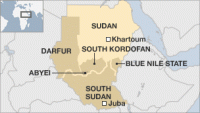
This post, written by Natasha Kieval, STAND Programs Intern, details the ongoing conflict between Sudan and South Sudan, specifially that in the states of South Kordofan and Blue Nile.
Last week the Tom Lantos Human Rights Commission held a hearing on the Sudans, government-sponsored violence, and the extent of the humanitarian crisis that subsequently emerges. Peace negotiations regarding Darfur are continuing in Doha. Since 2011, there has also been ongoing conflict in the southern Sudanese states of South Kordofan and Blue Nile, of which the principal victims are civilians. Although they were part of the southern struggle for liberation, these two states were treated differently during the negotiations of the 2005 Comprehensive Peace Agreement (CPA) and are now considered part of the north, without self-determination. Today’s conflicts arise between Khartoum’s government forces (SAF) and opposition groups including the Sudan People’s Liberation Movement-North (SPLM-N). The SAF also recruits poorly trained local militias that pit communities against each other. The conflicts between the government and the opposition have largely reached a stalemate which has caused the government to resort to aerial bombardment. This bombardment not only kills civilians but destroys the land, making the people unable to farm and feed themselves. As a result of the violence and systematic discrimination, 95% of people in South Kordofan have less than 1 meal per day, and this year, 1 in 5 households will experience a large gap in accessibility to food. The government is also preventing humanitarian access to most opposition-controlled areas. There have also been reports of increased ethnic tensions, especially in the Jonglei state of South Sudan. Currently, 2.3 million Darfuris are displaced, including 300,000 refugees in Chad and 1.5 million people are displaced in the state of South Kordofan. In total, 5 million Sudanese need humanitarian assistance.
According to Nancy Lindborg of USAID, the main drivers of the conflict include loss of oil revenue due to the separation (Sudan lost 75% of its revenue when South Sudan separated) and accusations by both sides that the other is supporting armed groups. John Prendergast, of the Enough Project, spoke about what the US government can do to help end the conflict: promote a comprehensive peace, support the Sudanese Revolutionary Front (SRF), which is a coalition of opposition groups, and support independent news and TV. Prendergast also suggested enhancing coalition building and helping civil administration groups to build institutional capacity. E.J. Hogendoorn of the International Crisis Group added that any post-Bashir transitional government must include the current government, the National Congress Party (NCP). Current Sudanese President Bashir has gone back and forth on whether he will seek re-election in 2015. The NCP is also experiencing economic difficulty, but it remains in power and continues to pursue violence.
While conflicts like that in Sudan often seem out-of-reach and unchangeable, it is important to remember how vital students are in bringing attention to them. One recurring theme during the hearing was the importance of students’ involvement in publicizing the Sudan conflict. This was mentioned by not only activist John Prendergast but also Rep. Frank Wolf. Members of Congress are listening, and they want to hear your voice. Don’t just stand by, stand up!
